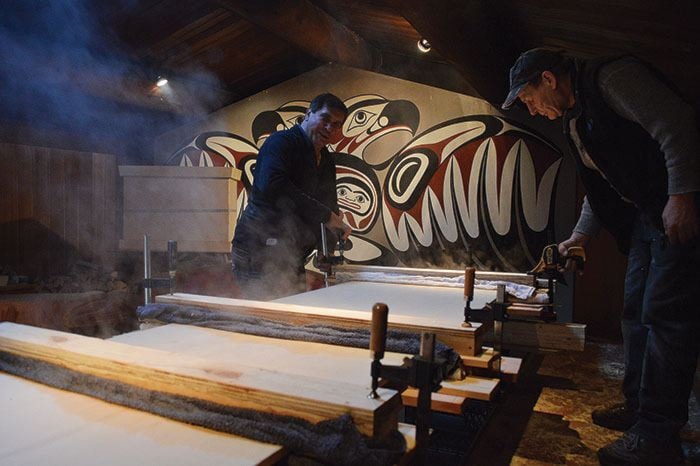Richard Krentz runs his right hand across the super-smooth grain of a yellow cedar board more than a thousand years old. It’s absolutely flawless and its perfection brings a smile to the face of the Coast Salish artist as he works in his Saratoga Beach longhouse with two old friends.
“It doesn’t get any better,” he says with a nod.
Krentz now lives full-time in Vancouver, but he was back in his old stomping grounds this week to complete a project that’s been on his mind for nearly two decades.
Twenty years ago the former logger acquired five old growth yellow cedar logs. Three came from the Nimpkish Valley, another from the Port McNeill area, and the last from Gold River.
Finally, on Monday, the transformation of this sacred cedar began under the expert hand of Krentz and his longtime friends, Ron Bracket and Dana Gibson. Over two days they measured, cut, steamed and formed the 30-inch boards into five very large bentwood boxes and five huge drums that will become the centrepieces of a new First Nations cultural show.
“We need to go to the next level of Indian performances,” says Krentz, who’s never been afraid to modernize traditional West Coast aboriginal art forms. “People are used to seeing Cirque du Soleil. The bar has been raised and we need to step it up.”
To that end Krentz has built 30-foot long eagle wings that will flank the stage, the audience will enter through a gauntlet of drummers and then the five “super boxes” will help tell the cultural stories that have been passed down through generations. But today the focus is on getting the boxes bent without splitting the irreplaceable boards.
“The secret is judging those curves. If you break one there’s no second chance and then all you have left is a defeated man!” he says with roaring laugh. “It’s all by feel. You can measure…but the oldtimers understood that you had to use your eye.”
They use traditional knives, power tools and a home-made steam system to soften the wood.
“We heat it up to 212 degrees (Fahrenheit) and then let it steam for at least 20 minutes, usually 40. It’s got to be super-hot,” notes Krentz.
The board is heated at the bending points and once hot enough, it takes Krentz and Gibson just a few minutes to roll the wood into the box shape. The final seam will be joined with wood pegs. Yellow cedar tops and bottoms are added, and then Krentz will spend months carving and painting the boxes in time for next summer’s performances.
“We’ve hooked up with the Rocky Mountaineer railway and we’ve booked the Sagebrush Theatre in Kamloops for a month,” says Krentz. “I also want to bring this show to the Tidemark Theatre in Campbell River.”
While Krentz has modern tools to build the boxes and drums, he marvels at the native artists before him who used hot stones to steam the wood and who designed an ingenious interlocking corner that provides the strength of the bentwood box.
“The curve is so unique – to figure that out is genius,” he says.
Over the course of his artistic career, Krentz and his daughter made tens of thousands of tiny bentwood boxes for retail sale. After one customer ordered 14,000, the two never wanted to make another bentwood box again.
“This is different. This is the real McCoy and we’re all working together,” he says. “It renews your spirit to create something like this.”
Steam rises from the boxes placed below the yellow cedar board and fills the inside of the red cedar longhouse. The two men work quickly to bend it into a box before the wood loses its elasticity.
“How is it Dana,” asks Krentz, “perfect?”
Gibson nods his head in agreement as Bracket chimes in with one word of approval, “Sweet.”
The 5 Boxes
- The 30-inch wide boards are from yellow cedar trees more than 1,000 years old.
- The boxes measure 2x4 feet and range from 32 inches to 36 inches in height. The biggest two have been nicknamed the “Emperor and Queen.”
- Each box tells a story, the first is the Raven Box for transformation.
- The second box tells the Legend of Lethlakay.
- The third tells the Coming of Man.
- The fourth is the legend, The Raven Steals The Sun.
- And the fifth, Child of Grace, tells the story of Princess Louisa Inlet where Krentz’ mother, Grace, was born.
- On his website, richardkrentz.com, Krentz writes, “In my earliest memory, I am lying in the bow of a canoe that my mother had helped her father to carve in the old way. I am wrapped in wool blankets against the cold of a starlit winter night. My mother would paddle across Blind Bay to reach an island where she could dig clams at low tide. I was too young to know that we were very poor and that life was hard for us. I only knew that I was safe in the warmth of the blankets, looking up at the stars and hearing my mother sing.”
